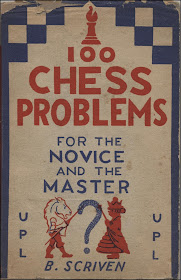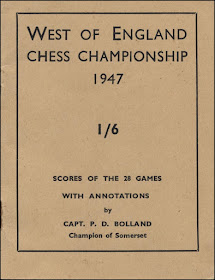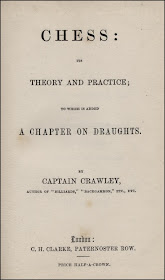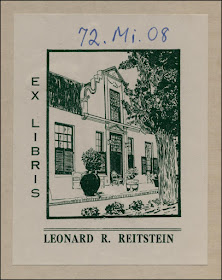I have just returned from a trip to Devon and Dorset where I acquired 25 or so chess books from book shops, two book fairs and specialist dealers Bob Jones of Keverel Books in Exmouth and Michael Sheehan of Caissa Books in London. Here are brief details of a few of these:
Chess and How to Play it by B. Scriven, London, reprinted 1938.
This book for beginners has been discussed several times in Edward Winter's Chess Notes where it has been described as Scriven's parvum opus. The book concludes with eight illustrative games including The Immortal Game between Anderssen and Kieseritzki with a note that this was "a recent County Championship game". A Game by Staunton is given on page 83 with no information on the occasion or opponent.
This is Staunton's first game against Alfred Brodie in the first round of The Chess Tournament of 1851. Brodie was a provincial player drafted in as a late replacement for Schumoff, of St. Petersburg, who failed to appear, and Staunton graciously included the following note on page 15 of The Chess Tournament, London 1852, following his second and concluding win over Brodie:
This is Staunton's first game against Alfred Brodie in the first round of The Chess Tournament of 1851. Brodie was a provincial player drafted in as a late replacement for Schumoff, of St. Petersburg, who failed to appear, and Staunton graciously included the following note on page 15 of The Chess Tournament, London 1852, following his second and concluding win over Brodie:
Scriven wrote a second chess book, 100 Chess Problems, for the Novice and the Master (cover title), 100 Chess Problems and End Games and a Hundred Solutions (internal title), London circa 1940's.
He also wrote a book on Draughts and Dominoes.
__________________________________
__________________________________
This very small booklet of 29 pages records the 28 games, with light notes, in a provincial tournament won by A. R. B. Thomas, of My 60 Memorable Games fame. (See Fischer's note to his 28th move of game 26 on page 166).
Note the unusual rates of play.
David Hooper, co-author of The Oxford Companion to Chess was another competitor and here is a photograph of Thomas in play against Hooper at the event. Thanks to Bob Jones of the chessdevon website for this photograph which is included in a comprehensive biograhy of A. R. B. Thomas.
Above: The competitors at the 1947 WECU Championship, showing A.R.B.
Thomas on the left in characteristic pose playing against D. V. Hooper, with
the owner of the restaurant venue looking
on.
The others in the photo are L - R: H. V. Trevenen; H. Wilson-Osborne (WECU
President); R. A. (Ron) Slade; Rowena Bruce; Ron Bruce; H. V. (Harry) Mallison;
Chris Sullivan; C. Welch (Controller); F. E. A. (Frank) Kitto.
__________________________________
Chess: Its Theory and Practice; to which is added a Chapter on Draughts, by Captain Crawley, London 1858.
This is a very nice copy, with all edges gilt, of the first edition of George Frederick Pardon's first chess book, issued under his pseudonym; Captain Rawdon Crawley. The first edition has 180 pages compared with the 191 pages of the fourth edition examined by Betts for his Bibliography. In his Preface, the author acknowledges his indebtedness to Staunton, "the prince of chess", Lewis, Walker and other authorities in preparing this volume. The material had previously appeared in Review, The Country Gentleman's Journal.
G. H. Pardon had previously written books on billiards and backgammon, and in 1860 he issued another small chess primer; A Handbook of Chess, the content of which was written for the London Journal.
__________________________________
Another extraordinary work by the industrious Fred Reinfeld, (and one of his last). In less than 200 pages he packs in the following:
Chapter 1. Chess Without the Masters. Covering the period up to around 1750, Reinfeld gives a brief history of chess and reviews the chess literature up to the time of Philidor.
Chapter 2. The World Champions and their Challengers. Reinfeld discusses the differences between world champions and also-rans, suggesting that determination accounts for the fine line between success and failure. He then briefly details the careers of Philidor, Labourdonnais and McDonnell, Anderssen and Morphy (no mention of Staunton), Steinitz, Lasker, Capablanca and Alekhine, with representative games of each and more references to early chess literature.
Chapter 3. The Also-rans. Here Reinfeld discusses various players of similar ability to the world champions but who never quite claimed the title. These include Zukertort, Tchigorin, Tarrasch, Pillsbury, Schlechter, Marshall, Janowski, Maróczy, Rubinstein, Tartakover, Nimzovich, Bogolyubov and Réti, with samples of their play.
Chapter 4. Drawn Games - Curse or Blessing? Reinfeld expresses his disapproval of "the notorious grandmaster draw" and gives as an example "the following obnoxious specimen":
He then gives four examples of exciting, hard-fought battles, each ending as draws; Englisch v Bird, London 1883; Halprin v Pillsbury, Munich 1900 (described as the most beautiful tournament draw ever played); Réti v Treybal, Carlsbad 1923; and Rojahn v Czerniak, Buenos Aires 1939.
Chapter 5. Blindfold Chess Masterpieces. Reinfeld was in awe of blindfold play and in this chapter he quotes from an article that he wrote for his earlier book Treasury of Chess Lore, about the mechanics of the process, before giving classic blindfold games by Morphy, Blackburne, Zukertort, Pillsbury, Alekhine, Koltanowski and Fine.
Chapter 6. The Fine Art of Annotating: The Old-Timers. In this final chapter Reinfeld discusses the considerable improvement in annotating over the last 150 years (up to the 1960's). He claims that early writers contented themselves with comments of a general nature which were not necessarily enlightening. Here he brings in Staunton, stating that, having done badly in the Chess Tournament of 1851, he took his revenge in the annotations in his book on the event, and gives a number of examples. Morphy's annotations on the Labourdonnais v McDonnell games in the New York Ledger are "only fair by present-day standards" but "they are a miracle of clarity and precision in comparison to other nineteenth century annotators"
Blackburne's annotations are "in the nature of vague generalisations, conversational in character, he might as well be remarking that "it's rather mild for January"". However, Steinitz "really initiated the modern school of annotation". Reinfeld gives two examples of Steinitz's fine analysis and notes, and, by the by, states that he was the first master to insist on the general superiority of Bishop over Knight.
Tarrasch; "one of Steinitz's outstanding disciples, became an even finer annotator", and his only rival in this field was Georg Marco. Reinfeld finishes by lavishing praise on two books from the 1920's: The Book of the New York International Chess Tournament, 1924 in which Alekhine's annotations "on which he is said to have spent a whole year, set a hitherto unknown standard"; and Schachkongress Teplitz-Schönau, 1922, about which Reinfeld declares "there are those who think that this masterpiece of Grünfeld and Becker is the greatest work of annotating that has ever been seen."
A wonderful book in its own right while prompting the exploration of many other chess works, and all this for £5.
__________________________________
The Chess Reader; The Royal Game in World Literature, compiled by Jerome Salzmann, New York 1949.
A collection of 108 extracts from general and chess literature. Some complete works are included, e.g. Stefan Zweig's The Royal Game, Goldsmith's translation of Vida's poem, Benjamin Franklin's Morals of Chess, Edgar Allan Poe's Maelzel's Chess Player, and Ernest Jones's The Problem of Paul Morphy.
This copy is from Leonard Reitstein's library.
__________________________________
Five further finds next time.
Five further finds next time.














No comments:
Post a Comment